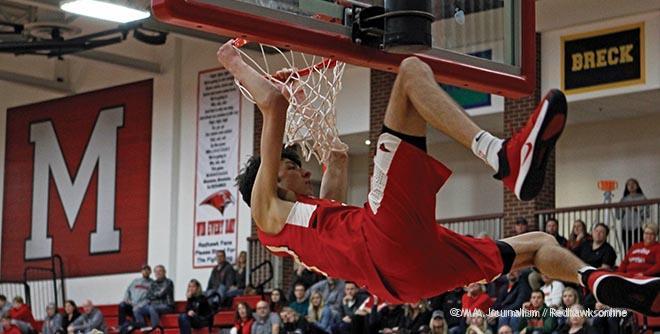For Holmgren, a long road to the top
Nation’s top recruit credits work, listening,
mindset, mentors for his rise
For the last few years, Minnehaha senior Chet Holmgren and former-teammate Jalen Suggs, now a freshman guard for top-ranked Gonzaga, have dominated state championships, AAU showcase tournaments, and ESPN rankings. Now, ESPN projects Suggs to be a top-five pick in the 2021 NBA draft, while they rank Holmgren as the number-one prospect in the Class of 2021.
But their paths to the top were not so similar.
Lance Johnson, head coach of the Minnehaha Academy boys’ basketball team, watched Suggs (@JSuggs23, @JalenSuggs2020) baffle crowds even as a child.
“Jalen was the star of the show back then,” said Johnson @Minnehaha_BBall. Holmgren (@Chet_Holmgren, @ChetHolmgren) joined Suggs’ team, the Minneapolis Hustlers, in third-grade. Larry Suggs, coach of the Hustlers and father of Suggs, first met Holmgren when he showed up at a practice.
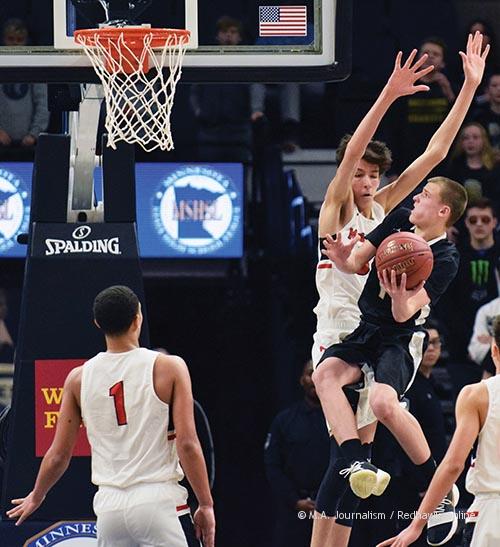
Minnehaha sophomore Jalen Suggs watches 6’9″ freshman Chet Holmgren turn a layup into a turnover in the Minnesota state final, a 73-60 win over Caledonia on March 24, 2018. Photo by M.A. Journalism.
“This skinny little kid comes strolling around the corner, and the myth was that he was six-foot tall in the third grade,” said Suggs. “Quickly I found out that he was only probably about four-foot, six.”
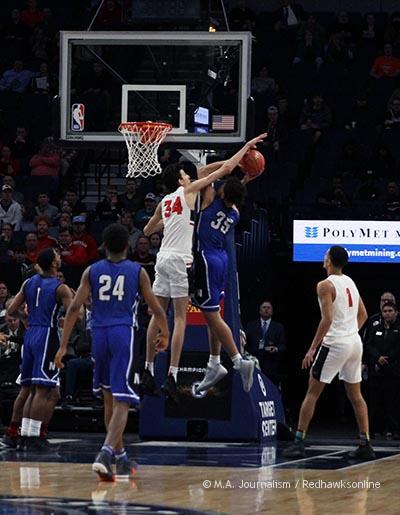
Reaching 7’0″ as a sophomore, Holmgren had a breakout year, helping the Redhawks to a third-straight state title, beating Minneapolis North in the final in March 2019. Holmgren would become the top shot-blocker in the nation, but the process took time. Photo by M.A. Journalism.
Seeing him dressed in cargo shorts and a t-shirt, Suggs asked Holmgren a few questions.
“I said, ‘Chet, have you ever played basketball before?’ Chet says, ‘Yeah.’ I ask, ‘Are you good?’ He said, ‘Yeah.'” Suggs then threw him in the practice.
“Very quickly I found out that Chet’s level of good was not the same as my level of good,” Suggs said, “but he tried very hard. It was interesting to see him still hanging in there with such a talented group of kids. It was a treat to have him back then.”
Holmgren recalls that season as a prologue to his success.
“If we were up by 30 with a minute left – that’s when I’d play,” said Holmgren. “I started in third grade, and a lot of people start once they can walk, so I was playing catch up for a while. I wasn’t very good, but I had fun.”
Around this time, he also began watching the NBA, tuning into the 2011 playoffs.
“I was on the OKC bandwagon when they had Russ, KD and James Harden,” Holmgren said. “And then I kind of liked the Mavs, because they beat LeBron.”
Holmgren credits his father, Dave, a 7-foot center who played four years for the University of Minnesota in the 1980s, for introducing him to the game at a very young age.
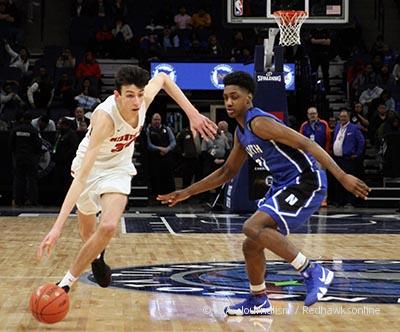
Holmgren had a triple-double in the state final his sophomore year. Photo by M.A. Journalism.
“He used to play,” he said, “and he knew I was going to be tall.”
Still, his dad could not have predicted his success.
“He wasn’t expecting all this,” he said.
‘Yes, I want to be good’
From his first elementary-school practice with the Hustlers, Holmgren was a great listener.
“I said, ‘Hey, do you want to be good?'” Suggs recalled. “‘Chet says, ‘Yes, I want to be good.’ I said, ‘Can you listen?’ He says, ‘Yes, I’m a very good listener.’ And from there on we’ve had a really good relationship.”
Suggs taught him the fundamentals, starting with form shooting.
“He couldn’t enter practice until he got 250 shots up from underneath the rim,” said Suggs.
Junior Prince Aligbe (@prince_buckets, @prince_buckets), a Minnehaha and AAU teammate, met Holmgren for the first time
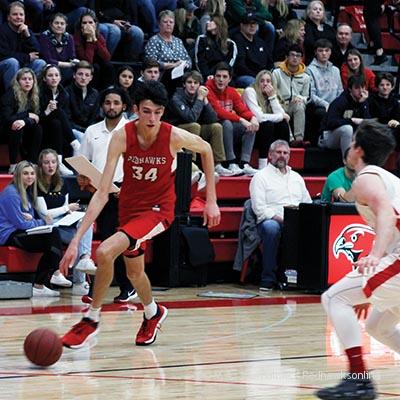
By his junior year in high school, Holmgren was running the floor like a point guard, leaving defenders helpless. Photo by Annika Johnson.
while guest-playing on an AAU team in sixth grade. Both were playing in an older age group.
“He could shoot,” said Aligbe. “That’s what stuck out to me. He was always playing up so he’d use his shot.”
They progressed to ball handling, then rim defending. Holmgren kept working and kept adding to his game.
“Once he had the basics down,” Suggs said, “we basically moved him to the corner, where he was really considered a three-and-D guy. He’d shoot corner threes, and he’d protect the paint.”
Even when the Hustlers were made up of 3rd- and 4th-graders, they often played against older age groups, sometimes even two years older. They continued to play against older kids as the team developed and eventually became known as the Sizzle. Because Holmgren played with older kids so often throughout middle school, the skills he was developing didn’t stand out as much. That is, until he hit a growth spurt.
“As we played more and more he just started to learn more concepts about basketball,” said Suggs. “I’d say it really hit him in the ninth grade once he took that growth spurt.”
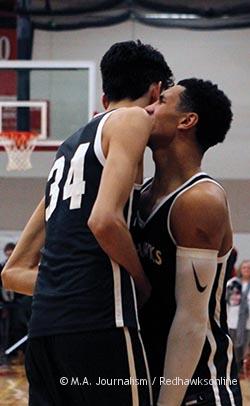
Holmgren and Suggs celebrate a 61-53 win over rival DeLaSalle in packed Minnehaha gym Feb. 22, 2020. Photo by Ann Oakman.
Holmgren took on bigger roles as his height kept increasing. By ninth grade, he’d become one of the best shooters on the team, so Suggs changed his position.
“We switched him to two guard and brought him off a lot of flare screens and curls,” he said. “Everybody in America didn’t believe we had a 6’9″ two guard.”
Staying focused, mentally tough
Aside from his size and style of play, though, Holmgren’s mental game has always defined him as an athlete. He said his personal goals have been the same since his youth: to simply “get better every day.”
“When I was younger, I wouldn’t think about the future much. I’d just live in the moment, and it wasn’t until later when I started thinking long-term,” said Holmgren.
Even as a bench-player in his youth, he wasn’t afraid to go head-to-head against his talented teammates in practice.
“Watching him grow up and play with Jalen, he was highly motivated to be the best basketball player he could possibly be,” said Larry Suggs. “And if that meant that he had to be better than Jalen, that’s what he was going to do. That’s what I love about the kid.”

Prince Aligbe. Photo by Beck Westrem.
Aligbe has also seen Holmgren’s confidence and determination distance him from his opponents.
“Chet’s aware of the work he’s put in, and he holds up to it,” said Aligbe. “He goes out there knowing he won’t be stopped from shooting and blocking shots.”
Holmgren believes the mental game is often overlooked, and that training this skill all boils down to repetition.
“It’s just about playing a lot of basketball so you know you’ve been through every situation already,” he said. “Then, when it happens, you can just calm yourself down.”
His mental preparation is simple before a big game.
“I never get scared because I know what I can do,” he said. “I just try to run through my head, I try to envision myself being successful before a game. I kind of try and plan out the game in my head before it even happens. There’s more pressure to perform and expectations. I just kind of go do what I do … stuff will take care of itself.”
The breakout year
“His sophomore year, he was just phenomenal,” said Johnson.
Holmgren started piling up many more points per game, contributing more than just three-pointers.
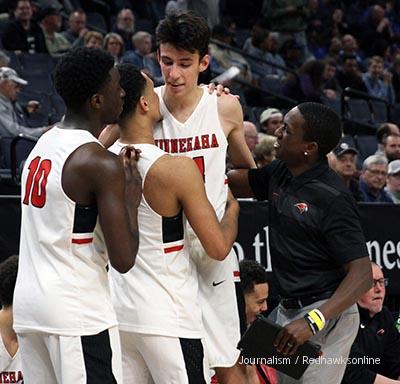
Aligbe, Suggs and Holmgren celebrate a third championship at Target Center with Minnehaha’s assistant coach Chandler Sentell. Photo by M.A. Journalism.
“Now, he’s scoring off the dribble and from the three,” Johnson said, “so he’s become extremely well-rounded as a scorer.”
In 2018-19, the Minnehaha boys’ basketball team was returning from back-to-back state championship wins, and Holmgren had spent the offseason playing up
in U17 AAU tournaments around the country with many of his Minnehaha teammates.
Johnson recalls one of Holmgren’s outstanding performances that year, where his play seemed to raise everyone’s expectations.
“In his sophomore year, when we played St. Paul Central, he had around 15 blocks,” Johnson said. “You could see that he was going to be able to dominate.”
Finally the elements of his game had clicked: his height (he was listed at 7’0″ in 10th grade), coordination, mentality and technique were all in sync.
“After I hit my growth spurt, I grew into my body and learned how to move my body,” Holmgren said. “That’s when I started to pass people up, even older kids.”
His statistics tell the story. As a freshman with the Redhawks,
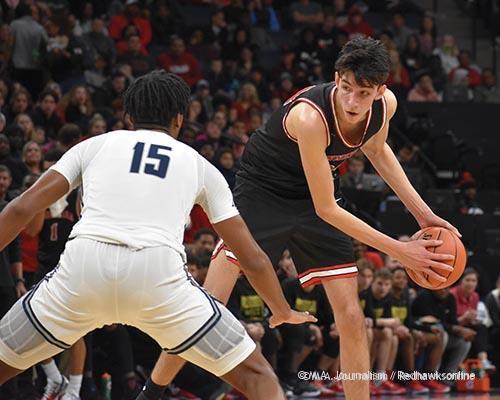
As a junior, Holmgren and the Redhawks defeated an all-star lineup from Sierra Canyon (Calif.) on Jan. 4, 2020, in front of 17,000 fans at Target Center in Minneapolis. COVID-19 would cancel the 2020 state tournament, blocking the team’s bid for a fourth-straight championship. Photo by Annika Johnson.
Holmgren averaged 6.4 points, 4.8 rebounds, and 2.1 blocks per game. As a sophomore, he averaged 18.2 points, 9.8 rebounds, and 5.5 blocks per game. His shooting percentage improved from 49 percent to 62 percent. His free-throw shooting improved from 57 percent to 72 percent. He finally had reached a level that could compare with his teammate, Jalen Suggs, but in a different way.
Johnson pointed out that Holmgren’s defense gave the Redhawks a huge head-start. If he blocked 10 shots in a game, he was essentially giving his team a net gain of about 20 points before scoring a single basket.
The team had a 29-2 season, winning their third-straight state championship. The final game, against traditional basketball power Minneapolis North, was a highlight for Holmgren.
“We played North, who didn’t stop chatting, and beat them by 20,” Holmgren said. “It was just a good time.” He had 16 points, 14 blocks and 10 rebounds.
The following season, the Redhawks were looked at as possibly the best team in the history of Minnesota high-school basketball. They drew a crowd of more than 17,000 to Target Center in Minneapolis, where they defeated the Sierra Canyon (Calif.) Trailblazers, 78-58, on Jan. 4. Facing a lineup that included Ziaire Williams, BJ Boston, Amari Bailey, Zaire Wade and Bronny James, Holmgren led Minnehaha’s defense with 12 blocks and 10 rebounds.
The Redhawks were 25-3 on March 12, 2020, when they won a sectional title to qualify for the state tournament and go for their fourth-straight title. The next day, the Minnesota State High School League ended the season because of the growing COVID-19 pandemic.
Now that he’s a senior, without the teammate he had always “played up” with, Holmgren has become the team’s focal point. Larry Suggs said he’s been a superb senior captain.
“One thing I’d say that Chet really has done well, he’s a terrific leader,” said Suggs.
Senior power-forward Aidan Phelps calls him a revered captain.
“I was having a rough practice, and he pulled me aside and told me that I just have to be confident in myself,” said Phelps. “That’s just the type of person Chet is. He’s there for you when nobody else is.”
The next level
Holmgren knows college basketball will require him to play faster and increase his “basketball IQ.” As for his style of play, he’s not too concerned about the transition.

On Jan. 16, 2021, Holmgren played the home-opener of his senior high-school season in front of a restricted crowd, due to the pandemic. He had 26 points in a 101-44 win over St. Louis Park. Photo by Beck Westrem.
“I don’t think my game will change so much as it’ll get refined,” he said. “I’ll get better in certain aspects, where I can do certain things over and over and they’ll work every time.”
Holmgren loves the intensity college basketball will bring, an intensity that high-school hoops can’t because of the typical schedule.
“In high school,” he said, “[you’re] going to have a week of practice, and then the season. [In college], it’s like eight months to learn, you’re practicing every day, learning everything that the coach wants you to learn [so when] the season comes, everything runs smoothly.”
As the nation’s top prospect, Holmgren has been heavily recruited. He said he has approached the process with a definite strategy.
“I’m looking for fit,” he said. “How am I going to fit in, offensively and defensively? At the end of the day, [coaches] got a job, so they’re going to tell you what you want to hear to get you on campus.”
He is a very good listener, but he can filter what he hears.
“You got to go off their track record,” he said. “Instead of going by what they tell you they’re going to do, go by what they have done before. You got to go with what they’ve done, not with what they say they’re going to do.”
With at least 30 Division 1 offers to choose from, Holmgren named seven programs for his final list: Minnesota, where his dad played; Michigan and Ohio State, also in the Big Ten; Gonzaga, where Suggs is a freshman star; along with Memphis, North Carolina and Georgetown. And, as his teammate Suggs knows well, playing overseas or in the NBA’s G-league are also options.
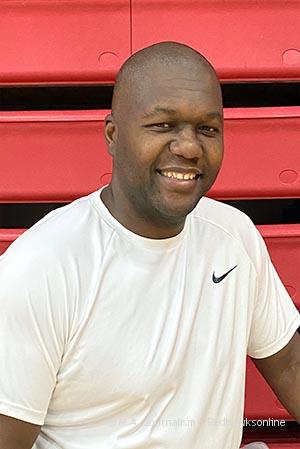
Larry Suggs in the Minnehaha gym. Photo by Beck Westrem.
Larry Suggs, whose first impression of Holmgren was less than optimistic, now thinks it’s possible that “at one point in time, he could be like Kevin Durant” — an unusually athletic tall player. Suggs points out that Holmgren has developed into a great distributor in addition to being a shot-blocker and shooter.
“His passing ability as a seven-one big man right now is unbelievable,” he said.
At this point, what is he most proud of?
“It hasn’t happened yet,” Holmgren said, “but I’d say graduating high school. It’s been a grind.”
Holmgren is the first to thank those who have helped him get better every day. He said he is especially grateful for his dad’s influence, support and advice at every stage of his growth.
“My dad put me in every position to succeed with my coaches,” he said, “and together they put me in this position.”
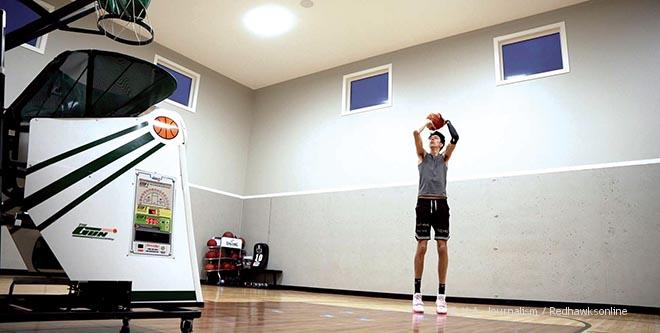
Holmgren works out at a private Twin Cities gym before the start of his senior high-school season. Photo courtesy of Chet Holmgren.

